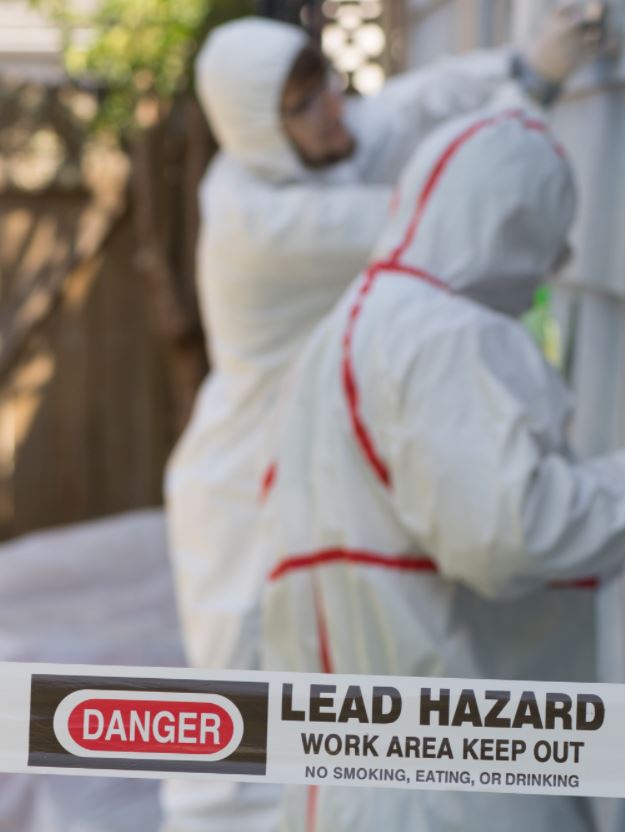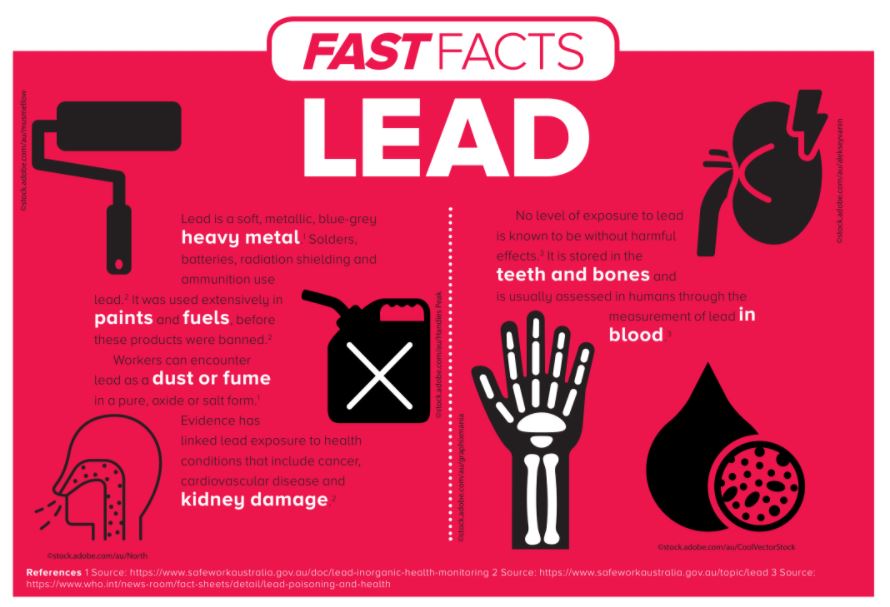Occupational Lead Exposure Managing Risk
Sponsored Article by NSCA Foundation Ltd
Australia is the world’s leading producer and exporter of lead, so it is critical that employers and workers who engage with this toxic material take steps to eliminate or limit exposure, to mitigate health effects. Lawyer VICTORIA KEAYS explains the risk lead poses in modern workplaces together with suggested actions that can be taken to mitigate these risks. After all, lead is a risk to workers, who face significant health consequences if exposed, and to employers, who face significant consequences if they fail to meet their obligations under relevant health and safety laws.
Humans have used lead for at least 5000 years due to its durability and resistance to corrosion. Given our longstanding use of this metal, lead poisoning has long been recognised as an occupational risk. These days, most people are aware that exposure to lead is carcinogenic. That said, lead still poses a risk in modern workplaces — both to workers, who face the risk of significant health consequences, and to employers, who face significant consequences if they fail to meet their obligations under relevant health and safety laws. Australia is the world’s leading producer and exporter of lead, so it is critical that employers and workers who work with this toxic material take steps to eliminate or limit exposure to mitigate health effects.
Lead exposure can lead to devastating health consequences. These include cancer, kidney damage, cardiovascular disease, intellectual disability and birth defects in children, anaemia, behavioural changes and broad effects on the nervous system. The Institute for Health Metrics and Evaluation (IHME) has estimated that in 2017, lead exposure accounted for 1.06 million deaths and 24.4 million years of healthy life lost worldwide due to long-term health effects. IHME also estimated that in 2016, lead exposure was responsible for 10.3% of the global burden of hypertensive heart disease, 5.6% of the global burden of ischaemic heart disease, 6.2% of the global burden of stroke and 63.2% of the global burden of idiopathic developmental intellectual disability.
HOW DOES LEAD EXPOSURE OCCUR?
Lead is a naturally occurring metal, found in the earth’s crust. Over the years, it has been widely used in a number of contexts such as mining, manufacturing and smelting, and is today used commonly in solders, batteries, ammunition and radiation shielding. Historically, lead was frequently used in paint and gasoline; this still occurs in some countries. These days, more than three-quarters of the world’s lead consumption occurs in the manufacture of car batteries. As the leading producer and exporter of lead, Australian workers involved in the mining and smelting of nonferrous lead face significant risk, particularly in the mining cities of Mount Isa, Port Pirie and Broken Hill.
Lead exposure can occur by inhalation of particles that are released during the burning of lead. Commonly, this occurs in smelting processes, stripping of lead paint, recycling and using leaded gasoline or aviation fuel. In addition, lead exposure can also occur through ingestion of dust that is contaminated with lead, drinking water that has passed through lead pipes and from food that has been stored in containers contaminated with lead. Lead accumulates in the body over time and deposits itself in teeth and bones. As bones age and deteriorate, lead can be released into the bloodstream.
WORKERS AND WORKPLACES MOST AT RISK
Workers in the following occupations and industries are at significant risk of excessive lead exposure:
• Battery manufacturing
• Lead mining
• Lead smelting and refining
• Construction and demolition
• Chemical industry
• Foundry workers
• Petrol station attendants
• Jewellery manufacturing
• Pipe fitting
• Printing
• Rubber industry
• Recycling industry
WHAT CAN AND SHOULD EMPLOYERS DO?
There is no safe level of lead exposure in the body, so the aim for employers should always be to eliminate any and all risk of exposure to lead. Where elimination is not reasonably practicable, employers must reduce the risk by ensuring:
• lead contamination is confined to an area designated for lead processes;
• lead process areas are clean and people are prevented from eating or drinking in such areas;
• an eating and drinking area that is free from lead contamination is provided for workers.

Employers have an obligation to identify “lead processes” and “lead risk work”. A lead process is one that exposes a worker to lead particulates, lead dusts or lead fumes (eg, grinding, sanding or welding), lead in batteries or battery parts, molten lead containing alloys and lead-based spray paint, including any abrasive blasting. Lead risk work is defined as any work that
will likely cause blood levels of a worker to exceed 20 μg/dL (0.97 μmol/L), or in the case of females with reproductive capacity, 5 μg/dL (0.24 μmol/L). These levels are a reduction from previous permissible levels. It is important for employers to be aware of this change.
There are steps employers need to take before any lead risk work takes place in their business. Firstly, employers must provide information about the health risk to workers before they engage in lead processes. In addition, employers must provide health monitoring to workers who perform lead risk work. Such monitoring is to occur both before the work starts and one month after. One of the key tenets of health monitoring is testing the levels of lead in workers’ blood, known as biological monitoring. Such monitoring must occur at regular intervals, depending on a worker’s age, gender, previous results and reproductive capacity. Results must be provided to the worker and be confidentially kept by the employer for at least 30 years.
In addition, employers should:
• provide and maintain changing rooms and showering facilities to minimise contamination;
• provide appropriate personal protective equipment (PPE) such as dust coats and respirators;
• make sure contaminated PPE is disposed of correctly;
• confine the area in which lead processes are performed, and ensure it is away from areas where food and drink can be consumed.
Employees also have duties when it comes to working with lead. These include not eating, drinking, chewing gum or smoking in a lead process area, removing lead contaminated clothing before entering an area designated for eating or drinking, and washing their hands and face after leaving a lead process area before eating or drinking.
REGULATORY GUIDANCE
Each state has relevant occupational health and safety laws that need to be complied with when working with lead. Employers who have identified lead processes or lead risk work in their business should contact their state regulator for advice. In addition to state-based rules, Safe Work Australia (SWA) has developed model Work Health and Safety Regulations, which also specifically set out how to use, handle and store lead in the workplace.
In 2018, these Regulations were amended to reduce the allowable workplace exposure standard, and to reduce permissible levels of lead in a worker’s blood. The relevant regulations in this area are technical as they deal with complicated medical issues. It is important that relevant employers familiarise themselves with the relevant rules.
LEGAL CONSEQUENCES OF OCCUPATIONAL LEAD EXPOSURE
Compensation for lead poisoning for workers has been recognised in Australia since at least the early 1930s. In 1931, 85 workers at Mt Isa Mines received compensation for lead poisoning, which occurred over a period of six months. Workers found to be suffering from occupationally induced lead poisoning are likely to be entitled to claim compensation from their employers. In its 2016 ‘Decision Regulation Impact Statement’ in relation to lead, SWA noted that between 2001 and 2014, there were 115 accepted workers compensation injury claims attributed to lead and lead compounds. Compensation paid in respect of accepted claims over this period totaled $2.57 million. The claims also resulted in an average 19.3 weeks’ duration of absence per annum.
Each state has its own workers compensation scheme with different requirements to claim compensation. However, if it can be established that a worker’s injury is due to lead exposure at work, they are likely to be entitled to payment of reasonable medical expenses, compensation for time off work and in many cases, lump sum compensation. As lead is particularly dangerous for pregnant women and unborn children, employers may also be liable for costs associated with caring for children born with disabilities due to parental lead poisoning.
It is worth noting that employers who, by their operation, contaminate the general environment in which they operate may also face expensive negligence actions, if such exposure leads to damage to the members of the general community. In addition, employers who allow workers to be exposed to levels of lead that cause illness or injury may face significant fines under occupational health and safety laws.
Even though lead is one of the oldest occupational carcinogens, workers still face risk of exposure in a number of industries, and employers face risks of litigation and fines for failure to deal with this toxic substance properly. Employers should make every effort to eliminate the risk of exposure to lead in the workplace. Where this is not reasonably practicable, there are strict and detailed workplace safety laws that employers must comply with.

